
Kieran’s Our City, Our Town Article, 27 July 2017
The Wheels of 1917: Revolutionary Women of Cork’s Northside
The Spirit of Mother Jones Festival and Summer School will be held in the Shandon area of Cork City from Tuesday, 1 August to Saturday, 5 August 2017. The programme is now online at www.motherjonescork.com. The Cork Mother Jones Commemorative committee was established in 2012 to mark the 175th anniversary of the birth of Mary Harris / Mother Jones in Cork, Ireland. After a highly successful festival marking that anniversary it was decided to make the festival an annual event marking the life and legacy of Mother Jones.
Although famous in other parts of the world, especially in the United States of America where she was once labelled “the most dangerous woman in America”, Cork born Mary Jones (née Harris) – or Mother Jones as she is perhaps more widely known – was virtually unknown and certainly not recognised as yet in her native city. The aim of the festivals and activities of this committee has been to get better recognition for Mother Jones in Cork and beyond.
On Wednesday evening, 2 August at the Mother Jones Festival, Anne Twomey of the Shandon Area History Group will speak on the topic of Revolutionary Women of Cork’s Northside, 1916-1923. The Shandon Cumann Na mBan group after 1916 provides a touchstone for many of the women. Below is an abstract from the notes the festival committee and Anne Twomey.
At the centre of the Cumann Na mBan group was Lil Conlon and her sisters. Lil was an unrelenting worker who carried out varied tasks during the troubled period. She later wrote a book Cumann Na mBan and the Women of Ireland 1913-1925 in which she pitched the question “What did the women of Ireland do anyway?”
Kate “Birdie” Conway, whose early career was as a professional operatic singer, later became a founder member in Cork of Cumann Na mBan and afterwards Shandon Branch president. She played a huge role from 1914 to 1922. Kate was born in Carrigaline and studied at the Cork School of Music under its principal A Teur, and took elocution lessons from J W Flynn. She developed a great soprano voice and gained the attention of the Cork Operatic Society with whom she performed. She embarked on a professional operatic career under the stage name Mlle Del Rita. One of her first professional leading roles was in Sir Charles V Stanford’s Shamus O’Brien (1896) in which she co-starred with Joseph O’Mara. She appeared at venues in Europe and North America before retiring prematurely from the professional circuit around 1900. Her last public appearance was in 1914 at the old Cork City Hall at a charity concert. She was involved in Conradh na Gaeilge in Cork from its foundation and was a pioneer of the Cumann na mBan movement, being president of the Shandon Branch at the time of the Anglo-Irish Treaty in 1921. She chose the pro-Treaty side in the civil war and dedicated much time to the well-being of the Free State army in the 1920s. She also devoted much of her time to the Magdalen Asylum, Sunday’s Well. Bridie died at Golden Grove, Douglas Road, Cork on 21 February 1936 and is buried in Carrigaline. Today she is remembered by a very colourful stain glass window in the entrance portal at the Ballinlough Church in Cork city. This was presented by her brother Maurice Conway in her memory. The window depicts the Little Flower to whom the deceased lady had a lifelong and enduring devotion.
Across in Blackpool, Peg Duggan and her sisters Sarah and Annie, living at 49 Thomas Davis Street, operated an escape network for those on the run for years. Her flower shop on Parliament Street was a centre of Volunteer/IRA activity until closed by order of the British authorities. She was among the first on the scene of the murder of Lord Mayor Tomas MacCurtain in Blackpool on 20 March 1920. She rendered first aid and comfort for his widow, children and extended family.
Emma Hourigan who lived nearby at 45 Maddens Buildings was very active, running intelligence, putting up posters, campaigning and organising.
In the very heart of Cork City in St Augustine Street stood the innocent paper shop run by the Wallace sisters who were members of the Irish Citizen Army. This unassuming premises was effectively the intelligence post office for the volunteers and the IRA for 5/6 years. Nora and Sheila Wallace’s heroic and invisible contribution to the revolution is only now surfacing from the shadows.
Other Cumann na mBan members included Margaret Lucey who typed drafts of Terence MacSwiney’s book Principles of Freedom. MacSwiney’s sisters Mary and Annie spent their entire lives working for the achievement of a Republic.
Young Kitty Daly was very active; she took part in the burning of Macroom Railway Station and was involved in the ambush of a British officer near the present St John’s School.
Geraldine Sullivan (Neeson), was Muriel Murphy’s bridesmaid at her marriage to Terence MacSwiney on 9 June 1917. She transported explosives on her person around the city.
Nora O’Sullivan was actively involved and bravely hid and carried weapons for volunteers, who were subject to constant searches.
To learn more, check out the details of Anne Twomey’s talk on Wednesday 2 August, 7.30pm, Maldron Hotel, Shandon.
Captions:
905a. Mary Harris, aka Mother Jones (source: Cork City Library)
905b. Centre glass panel is Kate “Birdie” Conway Memorial Window, Our Lady of Lourdes Church, Ballinlough, present day (picture: Kieran McCarthy)
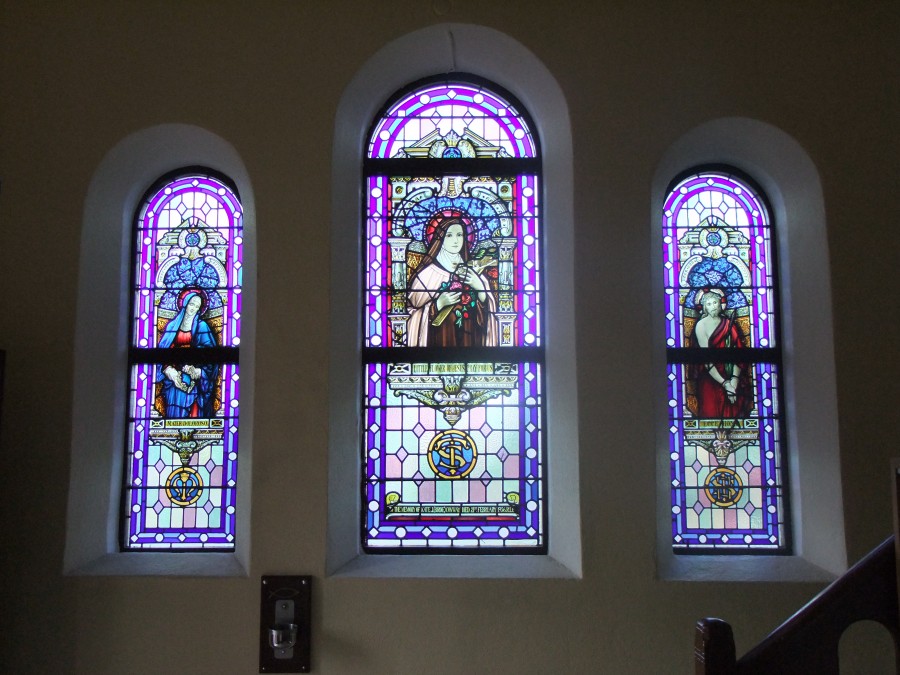
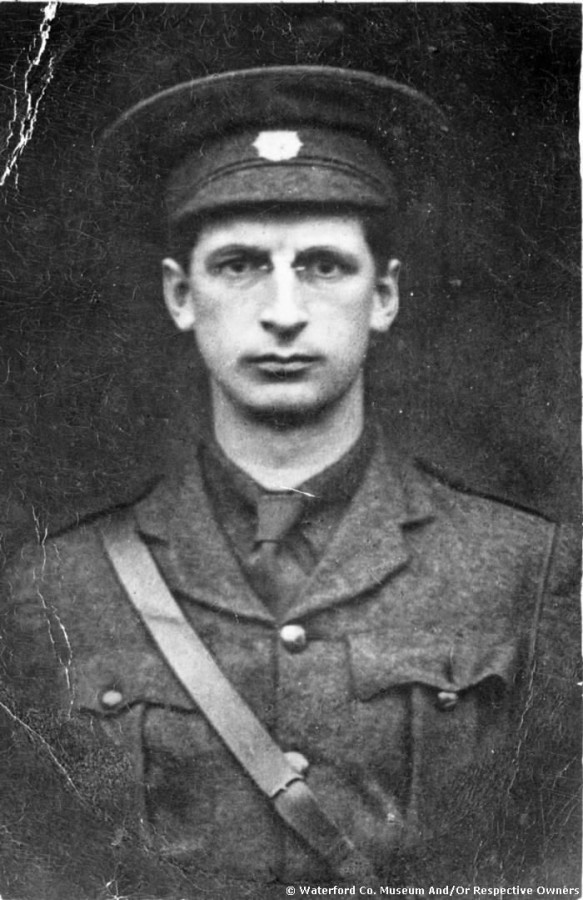
Kieran’s Our City, Our Town Article, 20 July 2017
The Wheels of 1917: Jubilation and Commemoration
July 1917 was an eventful month for Cork City with important happenings being listed in the Cork Examiner. The Cork Improvement Bill or the Ford Plant project finally received Royal Assent and became law. The solicitor of Cork Corporation Mr Galvin made the official announcement at a Corporation meeting on 12 July. The Lord Mayor, Thomas Butterfield led the congratulations and heralded a new era of industrialisation. Officials and Councillors present called for the works to start as soon as possible.
By Saturday 21 July at the Cork City Assizes, Mr Justice Pim noted that the work in the old Cork Park had started and that men were actually at work preparing the site. Judge Pim hoped for increased prosperity in Cork; “I live in the hope that this enterprise is only the forerunner of others, which the present project will call into existence, and that the old and famous city of Cork will become more prosperous and famous. Gratitude and honour is given to the man in a foreign country in the time of his success and fortune had not forgotten his old motherland and the country, which gave his father birth”.
Of political significance was the election of Éamon de Valera as an MP in East Clare. This was a by-election caused by the death of the previous incumbent Willie Redmond, brother of the Irish Party Leader John Redmond who had died fighting in World War I. De Valera joined the Irish Volunteers at their first meeting in 1913. He took part in the landing of guns from the Asgard in July 1914. He commanded the Boland’s Mills garrison in Dublin during the 1916 rising. After the surrender, he was sentenced to death, but later it was decided to sentence him to life imprisonment instead. In prison, de Valera began to show his leadership qualities. He was released from prison in June 1917.
Late on Wednesday evening, 11 July 1917 many sub-agents and representatives of the two MP candidates returned to Ennis after the close of the poll to determine with any accuracy the chances of the opposing candidates. It was quite clear from the outward signs, that de Valera’s supporters considerably outnumbered those of his opponent Patrick Lynch, the Irish Parliamentary Party Home Rule candidate. De Valera won his seat gaining over 5,000 votes.
On the front steps of the courthouse the High Sheriff made his second formal announcement of the return of Mr de Valera. It was received by sustained public cheering and the waving of many Republican flags. De Valera spoke a few words in Irish first, and as then continuing in English crying out “England has her answer”. This was part of his continued call to abandon constitutional agitation in the form of the Irish Convention (which was due to begin in late July 1917) and to turn to physical force.
De Valera expressed his gratitude to the electors of East Clare for returning him and his pleasure at being elected for such an historic constituency. There were a number of personal encounters, but the force of police, around the town of Ennis acted as a powerful deterrent against anything in the shape of a general outbreak. Bands of Sinn Féin representatives in organised formation marched through the streets at intervals, all carrying substantial sticks or cudgels. At the Sinn Féin Ard-Fheis in October 1917, De Valera was elected President of the party and at the end of the same month he was elected President of the Irish Volunteers. His first arrival to a Sinn Féin rally in Cork was on 8 December 1917.
This month, 100 years ago, a discussion also began on the commemoration on the executed Easter Rising leaders. On 16 July 1917 the Round Room in the Mansion House, Dublin was filled to capacity as the leaders of Sinn Féin demanded that the bodies of the Easter Rising leaders so that they can be given a Christian burial. Fifteen leaders of the Rising were shot in the fortnight after the Easter Rising. Fourteen were executed in Kilmainham Gaol in Dublin whilst Thomas Kent was executed in his native Cork. The bodies of the 14 were taken to Arbour Hill military prison in Dublin for burial. The remains of Thomas Kent remained in Cork Prison. The manner in which their burials were conducted caused widespread anger at the time, with Bishop Thomas O’Dwyer stating that the British had denied the men a Christian burial by burying them in unconsecrated ground. No compromise emerged.
OPW historic records outline that from 1928, the Department of Defence suggested that the OPW erect a suitable memorial in Arbour Hill Cemetery to commemorate the leaders of the Easter Rising buried there. Finally, in 1937, T J Byrne, then principle Architect at the OPW, relented. The matter was delayed until 1948, when the Department of Defence eventually passed responsibility for the plot to the OPW. By this time, Arbour Hill Cemetery was a place of pilgrimage, although it was not officially open to the public. In 1949 extensive re-landscaping took place and the present design was submitted by the Department of Defence, the government, the Arts Council and by the OPW. It was approved in January 1954, the memorial park opened in 1955, and the memorial wall by Michael Biggs was completed in 1964.
July Historical Walking Tours:
Thursday, 27 July, The Friar’s Walk, with Kieran; discover Red Abbey, Elizabeth Fort, Callanan’s Tower and Greenmount area; meet at Red Abbey tower, 6.45pm (free)
Friday 28 July, The Lough and its history, with Kieran; meet at the green on northern end of the Lough, Lough Church end, 6.45pm (free)
Captions:
904a. Éamon de Valera, 1916 (source: Waterford Museum)
904b. Cadets stand to attention around the plot of the 1916 Leaders in Arbour Hill, Dublin, present day (source: Irish Defence Forces)
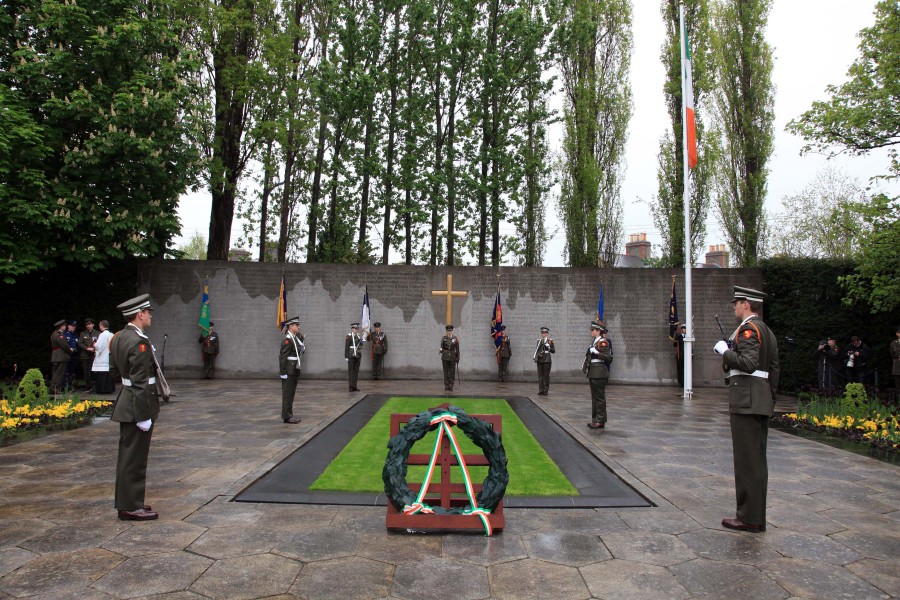
Cllr Kieran McCarthy has called for that any future plans for the Atlantic Pond area to continue to protect this historic amenity and its environs. At recent City Council meetings concerns were raised with regards to flooding and possible pollution at the Atlantic Pond.
On foot of the issues raised an initial inspection of the Atlantic Pond was undertaken by the Director of Recreation, Amenity and Environment and Parks Section. The results of this initial inspection indicate that the recent flooding, which occurred in the area at high tides, due to the malfunctioning non-return valve at the pond outlet to the river, has resulted in the brackish salt water causing some “wilting” of the vegetation in the areas that were flooded i.e. the green areas and island. It is the view of the Parks Department that the trees and shrub vegetation will fully recover however some of the lawn areas may need to be reseeded. At present a more detailed examination of the soil and vegetation is being arranged in order to verify these initial findings.
Cllr McCarthy noted: “it has been pointed out to ward councillors by the Director of Recreation, Amenity and Environment that at this point in time there is no evidence that the issues seen at present in the Atlantic Pond are associated with pollution or other such harmful substance in the water. It has also been confirmed that there is no link between the issues being experienced at present and those that occurred in January 2017 has been found”.
In January 2017, there was a discolouration issue in one of the rivers feeding the Atlantic Pond. Cllr McCarthy continued; “this incident was fully investigated by the Environment & Recreation Directorate however the source of the discolouration could not be identified despite significant survey and investigative works. The water samples analysed in January during the discolouration incident did not contain any harmful substances in the water and no negative impacts on either plant or animal life were recorded associated with this incident”.
The selling of Bessboro House and ground is a cause for concern, according to local Cllr Kieran McCarthy. “Any developments should wait for the Mother and Baby Home Commission to finish their work; so everyone has the range of testimonies before them and that informed decisions can be made on the future of such sites such as Bessboro”.
“The house and parts of its environs are earmarked for development in the Mahon Local Area Plan but historically we are dealing with a late eighteenth century house and estate with a vast history. The order of Sacred Heart of Jesus and Mary set up the Bessboro Mother and Baby Home in 1924 and it lasted till 1996. It is estimated that 8,000 to 10,000 girls and women passed through its doors. In recent years, media reports, secured from the HSE, have revealed the extent of infant mortality in the mid twentieth century – rough estimates highlight that there are 1,200 children are buried in the graveyard in Bessboro”.
Cllr Kieran McCarthy has welcomed comments by Minister Katherine Zappone of the Department of Children and Youth Affairs who last week called for open and consistent communication with former residents of the Irish Mother and Baby Homes on the matters of concern to them. The Minister has committed that the updates will be published in the Mother and Baby Homes section on the Department’s website on the first Friday of every month. Cllr McCarthy has agreed with the Minister’s comment that the public need to have access to the same information at the same time. Minister Katherine Zappone recently invited former residents and their supporters to participate in a facilitated consultation process following the publication of the Second Interim Report of the Commission of Investigation. Over 100 people participated in the initial event on 30 June reflecting the high level of interest in engaging with this process.
Cllr McCarthy continued; “I have called for arrangements for further events to be hosted in locations outside Dublin and across the country. Fourteen Mother and Baby Home and three County Homes are under scrutiny with the Mother and Baby Commission. It is highly important that as many people have an opportunity to have their say on their issues of concern on such Homes”.
Cllr Kieran McCarthy, a member of the European Committee of the Regions advocates for pan-European inclusion of science and innovation in school curricula.
On 12 July, during the 124th plenary session of the European Committee of the Regions, members hosted Mr Carlos Moedas, European Commissioner for Research, Science and Innovation who presented some possible directions for the future evolution of the Horizon 2020 programme.
Speaking on behalf of the European Alliance group, which he is Vice President of, Cork City Councillor Kieran McCarthy stressed the need to break the silos between disciplines, policies and programmes and the need to inspire Europe with mission-driven research and innovation.
Mr McCarthy called for a more central role for the European Commission’s Joint Research Centre and a better connection between the work done there, the research within the Horizon 2020 programme and the innovation elements of the cohesion policy.
Secondly, Mr McCarthy, who also authored the CoR opinion on “Building a European Data Economy,” talked about the crucial importance of inspiring Europe and capturing public imagination in science and innovation. He argued that ten per cent or more of future funding should go to publicity and science and innovation must form a core part of school curricula across every member state and local authority area. Giving the example of Cork City Council’s Lifetime Lab in Cork he concluded; “It must be a science for all. Science and innovation is the future of Europe. And the future of Europe document must reflect this going forward as well”.
Horizon 2020 is the biggest EU Research and Innovation programme with nearly €80 billion of funding available in the period between 2014 and 2020. Currently, the programme is undergoing its mid-term view with vivid debates on its post-2020 evolution and, in particular, its relation to the EU’s cohesion policy.
Caption: Cllr Kieran McCarthy addressing Commissioner Carlos Moedas and the European Committee of the Regions Plenary in the hemicycle of the European Parliament
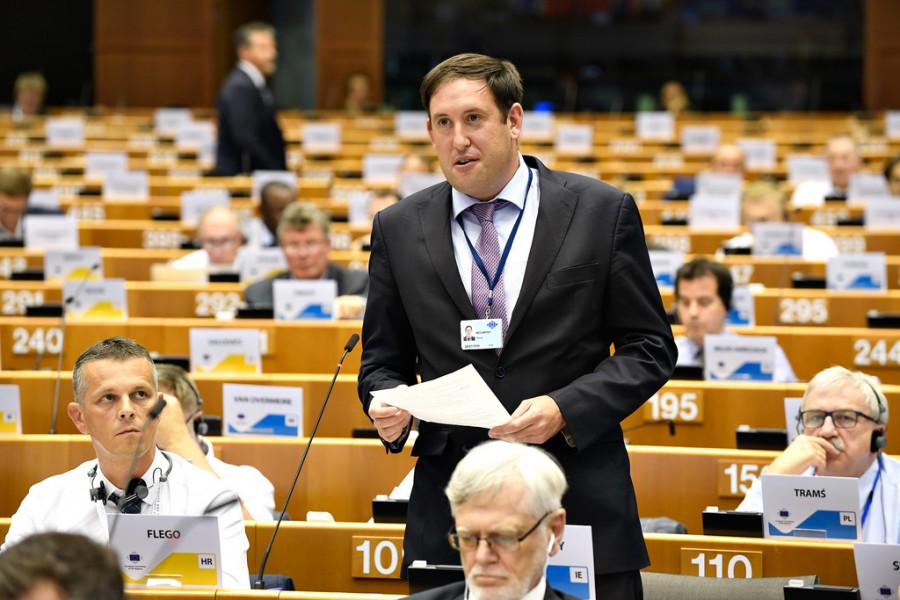
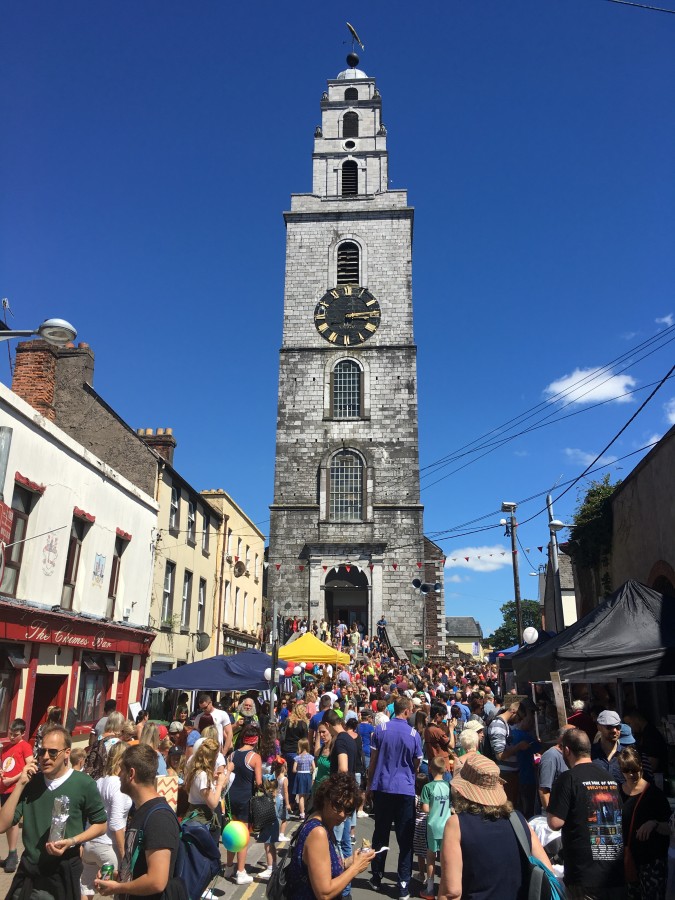
Kieran’s Our City, Our Town Article,
Cork Independent, 13 July 2017
July Historical Walking Tours
Wednesday 19 July, Shandon historical walking tour with Kieran; discover the history of one of Cork’s oldest streets woven with tales of castles, butter and historical churches; meet at North Gate Bridge at end of Shandon Street, 6.45pm (free, duration: two hours)
There are multiple layers of history around the Shandon quarter. Amongst them is the story of the great butter market. By the mid eighteenth century, the native butter industry in Cork had grown to such an extent due to British empire expansion that it was decided among the main city and county butter merchants that an institution be established in the city that would control and develop its potential. These ‘Committee of Butter Merchants’ located themselves in a simple commissioned building adjacent to Shandon. The committee comprised 21 members who were chosen by the merchants in the city. In May 1770, it was decided by the Cork Committee that all butter to be exported from Cork was to be examined by appointed inspectors – the quality and weight of the butter and the manner of packing.
Thursday 20 July, Sunday’s Well historical walking tour with Kieran; discover the original well and the eighteenth-century origins of the suburb, meet at St Vincent’s Bridge, North Mall end, 6.45pm (free, duration: two hours)
Sunday’s Well was a famous landmark through the ages and the adjoining district took its name from the well. In 1644, the French traveller M de La Boullaye Le Gouz, visited Ireland. In the account of his journey he writes: “A mile from Korq [Cork] is a well called by the English, Sunday Spring, or the fountain of Sunday, which the Irish believe is blessed and cures many ills. I found the water of it extremely cold”. Charles Smith in his second volume of his History of Cork, mentions “a pretty hamlet called Sunday’s Well, lying on a rising ground…here is a cool refreshing water, which gives name to the place, but it is hard, and does not lather with soap”. Antiquarian Thomas Crofton Croker described the well as well; “Sunday’s Well is at the side of the high road, and is surrounded by a rude, stone building, on the wall of which the letters HIS mark its ancient reputation for sanctity. It is shadowed over by some fine own ash trees, which render it as a picturesque object”. Writing later still John Windele says of the well; “Early in the mornings of the summer Sundays may be seen the hooded devotees with beads in hand, performing their turrish or penance, besides this little temple”.
The historic landmark is no longer visible. At the beginning of 1946, the adjoining roadway was widened and improved, it was necessary to remove the stone building covering the well, and to run the road over the well. However, to mark the site, the stone tablet bearing the inscription, “HIS, Sunday’s Well, 1644”, which had been on the building, was placed on the wall adjoining the road. Rounds are no longer paid there.
Thursday 27 July 2017, The Friar’s Walk, with Kieran; discover Red Abbey, Elizabeth Fort, Callanan’s Tower and Greenmount area; meet at Red Abbey tower, 6.45pm (free, duration: two hours)
This historical walking tour begins on Red Abbey square and explores the area’s medieval origins and the impact on the area. In such a small corner of the city, post medieval Cork and the story of industrial housing can be told, as well as stories of St Stephen’s School, Callanan’s Tower, Elizabeth Fort and the Gallows at Greenmount.
The central bell tower of the church of Red Abbey is a relic of the Anglo-Norman colonisation and is one of the last remaining visible structures, which dates to the era of the walled town of Cork. Invited to Cork by the Anglo-Normans, the Augustinians established an abbey in Cork, sometime between 1270 AD and 1288 AD. It is known that in the early years of its establishment, the Augustinian friary became known as Red Abbey due to the material, sandstone, which was used in the building of the friary. It was dedicated to the Most Holy Trinity but had several names, which appear on several maps and depictions of the walled town of Cork and its environs. For example, in a map of Cork in 1545, it was known as St Austins while in 1610, Red abbey was marked as St. Augustine’s. The adjacent street names of Red Abbey Street, Friar’s Street and Friar’s Walk also echoes the days of a large medieval abbey in the area.
Friday 28 July 2017, The Lough and its history, historical walking tour with Kieran (new tour); discover the legends and stories of the Cork Lough, meet at the green on northern end of the Lough, Lough Church end, 6.45pm (free, duration: two hours)
This is a new walking tour, which explores the Lough, its heritage and the rich surrounding history of this quarter of the city. This amenity has witnessed eighteenth century market fairs as well as ice skating to nineteenth century writers and nursery gardens to twentieth century cycling tournaments and the rich and historic market garden culture.
Kieran’s National Heritage Week historical walking tours for August are also now posted at www.kieranmccarthy.ie under the walking tours section.
Captions:
903a. View of Shandon Street Festival, June 2017 (picture: Kieran McCarthy)
903b. Depiction of Skating on the Lough by artist Daniel Maclise, c.1830 (source: Cork City Library)
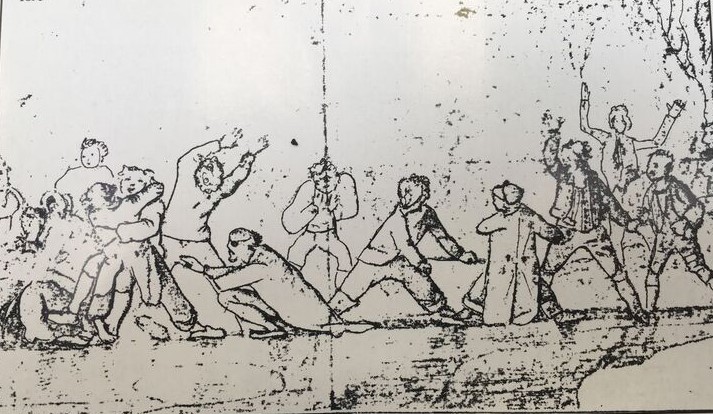
Cllr Kieran McCarthy has welcomed the recent announcement by the Recreation and Amenity Directorate of Cork City Council to provide funding of e.300,000 to resurface and to deal with drainage issues on Douglas Pool hill and carpark; Cllr McCarthy noted; “it goes without saying it has been a very difficult and frustrating process to unlock funding from the City Council to deal with one of the roughest patches of road in the city”.
Cllr McCarthy highlights; “I have made multiple calls over the years to the Chief Executive to invest in this long standing problem; sometimes one would wonder what is the point of people paying property tax if all of it ends up being spent on salaries and not on enhancing municipal services and resolving issues such as road resurfacing within localities”. On raising the issue of the pool area in recent weeks at Council meetings, Cllr McCarthy has been given a tentative start date of this September with completion to take a few weeks.
Losing the Past, Losing Ourselves
Published in Irish Examiner, 6 July 2017
Like everyone else on Cork’s Lee Fields, I watched with great sadness the burning of the old St Kevin’s Asylum (built c.1895-1899) and had that deep sense of shock and loss – not just at one level but across a number of levels – Yes – St Kevin’s Asylum had a harrowing past but it’s future should not have played out this way.
Chatting to Corkonians they expressed their sadness and frustration that a part of Cork’s social history was burning and being destroyed; they were sad to see a burnt scar of a landmark emerging on the cityscape in one of the city’s scenic spots – dismayed that it was a potential arson attack out resulting out of someone’s boredom, frustrated that campaigns over the years by resident community groups and public representatives did not gauge muster with the owners of the site, sad that the owners of the site, the HSE, did not get to pursuing a plan for the site (despite having completed some really tasteful renewal works in the old Cork workhouse at St Finbarr’s Hospital), upset for the memory and almost forgotten memory of former patients and former staff members, frustrated that in the national context, there are many other old asylum buildings that are decaying and not being utilised for a myriad of potential uses.
Huge depths of multiple feelings unveiled themselves along the banks of the Lee last evening – feelings that were all about responsibility around harnessing and how to capture for the present and future a city’s (and a nation’s) history and heritage.
The fishermen, who called in the fire sat on the river railing, lamented to the press on the emerging scarred landscape. The River Lee at this point is bound up with a necklace of beautiful nineteenth century buildings across it northern ridges– some with harrowing histories like Our Lady’s Hospital and the Good Shepherd Convent with its Magdalene Asylum – some with stories of innovative local government like the Old Waterworks, some with gorgeous artwork like the stained-glass windows in St Vincent’s Church. The former Our Lady’s Hospital is now in the last phase of redevelopment by a private developer as tastefully done apartment blocks – the old Waterworks is now a notable tourism attraction run by Cork City Council on Ireland’s Ancient East with themes around renewable energy, waste, education and science. Investment into these sites have worked and a return for the investment is being reaped as well as emanating sustainable best practice in what to do with old building stock. These are best practice examples.
The now burnt out old St Kevin’s Asylum and the ruined and formerly burnt out Good Shepherd Convent remain ‘worst case’ examples of what happens if one does not invest. The hands of local government councils need to be strengthened – that finance and staff are made available to compulsorily purchase property, which is not being developed. Cities, town and regions should not have to endure sadness, loss, frustration and dereliction. It is not positive to have buildings, small to large, boarded up for years, to leave them decay, and to not have a plan. Going forward we need to reverse our approaches to dereliction – ideas, future planning and investment are needed to breathe life into our historic cities like Cork – in fact anytime we have, the ideas of the past have worked and have always helped frame the visions of the future.
Dr Kieran McCarthy, Independent Councillor, Cork City Council, www.corkheritage.ie
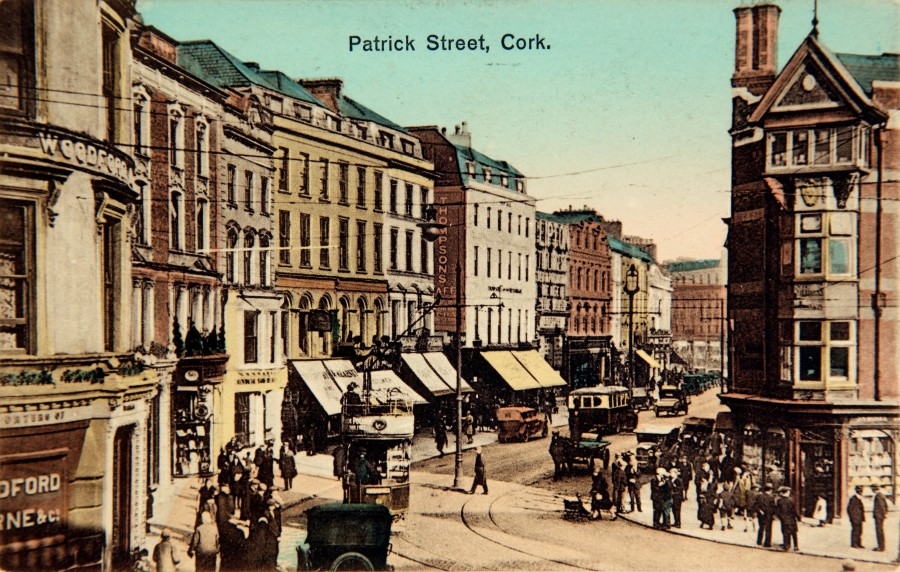
Kieran’s Our City, Our Town Article,
Cork Independent, 6 July 2017
The Wheels of 1917: Amnesty Disturbances
The evening of Sunday 24 June 1917 was one of violence on Cork streets. It followed the arrival home of the eight Irish Volunteers in Cork City (see last week’s article) on the previous day and a procession and speech-giving at the National Monument. Members of Sinn Féin continued their campaign of action over the ensuing 24 hours. The Cork Examiner records that the demonstrations began as a crowd of Sinn Féin supporters returned from a camogie match between Plunketts and Clan Emer, at O’Neill Crowley Grounds, Western Road. They were escorted by the Piper’s Band. When the Gaol Cross was reached an attack was made on the gaol, stones being thrown and some windows broken. Cheers were also raised for the Cork volunteers who were prisoners there, and these were answered with cheers from within the gaol walls.
This crowd then proceeded to Sheare Street and retook possession of the Irish Volunteer Hall, which the military had taken over. From mid afternoon until after 11pm riots were pursued. It started with an organised attack by youths on the Recruiting Office on St Patrick’s Street, the plate glass windows of which were smashed on the previous Saturday night. The smashed area was boarded up but the youths broke down this structure with sticks, removed recruiting posters from the window and tore down the flags, which hung over the facia board. A young man climbed the tramway pole opposite the offices and cut down the Union Jack, which had flown there since the beginning of the war. This was thrown into the river.
The crowd now numbered several hundreds, and young women whose relatives were in the war, incensed Sinn Féin supporters by attacking them. Under District Inspectors Walsh and Swanzy, the police – armed with carbine rifles, bayonets, revolvers and batons – were on the streets in full force. The police charged the crowd on St Patrick’s Street. Carbine rifles were lowered and bayonets fixed, and revolver shots cracked out now and again. The corner of King Street (now MacCurtain Street) and Bridge Street was the stand-off of the rival parties of both sides. The police on St Patrick’s Bridge prevented persons coming into St Patrick’s Street where Sinn Féin members were in strength. Canon O’Leary, Rev Father McSweeney, and other clergy of SS Peter and Paul’s Church, as well as 1916 veteran J J Walsh, arrived onto the streets during the disturbances counselling the people to go home, but their advice was ignored.
The answer by the police was to re-charge and re-charge. Several persons were wounded in the bayonet thrusts, by being struck with the butt end of the rifles. One man received shot wounds. Many fell and suffered bruises by being trampled on. All the wounded were all taken to the North Infirmary for treatment. One of the men, Abraham Allen aged 25 years, living at the North Mall, was shot in his thigh.
Shortly before midnight it seemed as if the centre of the city was about to return to normal and it was decided that a number of the police return to the Bridewell and Tuckey Street Barracks. About twenty police were marched to Woodford Bourne’s corner on Daunt’s Square, where they were ordered to halt, preparatory to proceeding to their respective barracks. There were very few civilians in this particular portion of the street at the time, but without warning a fusillade of stones, came from a dark corner at the square. A number of the police were struck, while many stones reached window on the Grand Parade tide at the street. A bayonet charge followed. The stone-throwers, who were few in number, ran through Castle Street, pursued by some of the police, and a number of women who had congregated at the entrance to Cornmarket Street. At the upper end of Castle Street, the stone-throwers entered North Main Street, and escaped their pursuers.
Portions of the crowd that had been driven from the flat of the city by baton and bayonet charges earlier in the evening began to return towards St Patrick’s Street, and another collision followed with the police. Many injuries were sustained. The crowd was soon dispersed. About 12.15am Sergeant Grey was brought to the Bridewell suffering from wounds under his left eye. It was caused by a revolver bullet, received in the course of action. Through the counter attacks on the baton and bayonet charges in St Patrick’s Street, several other policemen also sustained wounds.
About 11.15pm the military arrived on the scene, and took up positions between Fr Mathew Statue and Cash’s Drapery Store at the Winthrop Street intersection. This detachment was fully armed and cut off communication to the centre of the city. Their preparations for eventualities were elaborate. They had machine guns, which they placed in position to command St Patrick’s Street. They were accompanied by a chaplain, and brought with them a motor ambulance and stretcher bearers. The police in batches patrolled the various streets and cleared the crowds from the centre of the city, subsequently cutting off communication to it. It was nearly midnight when the violence quietened down and the military were withdrawn at 1.45am.
Secret Cork (2017) by Kieran McCarthy is now available in Cork bookshops or online at Amberley-books.com
Captions:
902a. View from Daunt Square side of St Patrick’s Street, c.1930 (source: Cork City Through Time by Kieran McCarthy & Dan Breen)
902b. View of Grand Parade c.1910 (source: Cork City Through Time by Kieran McCarthy & Dan Breen)
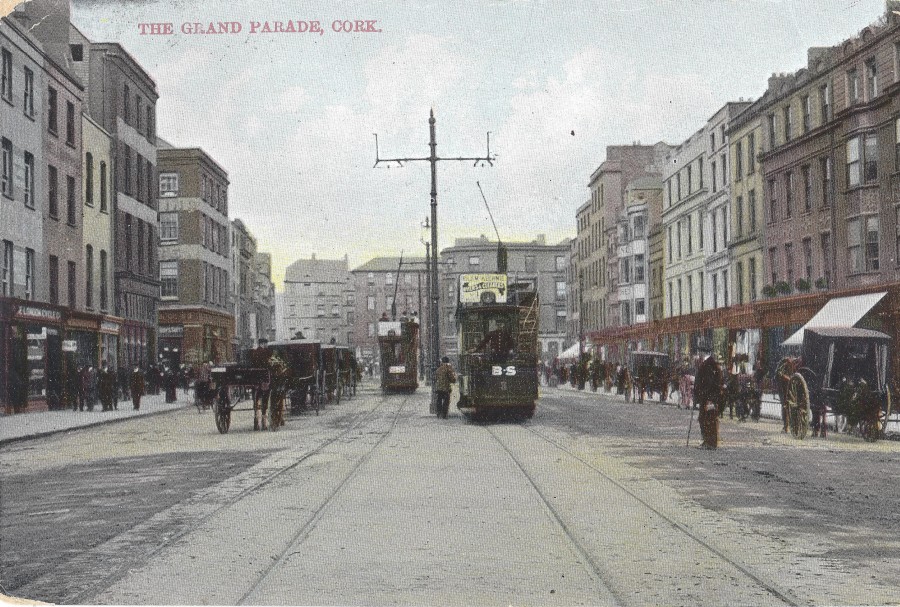
July Tours
Wednesday 19 July 2017, Shandon historical walking tour, with Cllr Kieran McCarthy; discover the history of one of Cork’s oldest streets woven with tales of castles, butter and historical churches; meet at North Gate Bridge, 6.45pm (free, duration: two hours)
Thursday 20 July 2017, Sunday’s Well historical historical walking tour with Cllr Kieran McCarthy; discover the original well and the eighteenth century origins of the suburb, meet at St Vincent’s Bridge, North Mall end, 6.45pm (free, duration: two hours)
Thursday, 27 July 2017, The Friar’s Walk, with Cllr Kieran McCarthy; discover Red Abbey, Elizabeth Fort, Callanan’s Tower and Greenmount area; meet at Red Abbey tower, 6.45pm (free, duration: two hours)
Friday 28 July 2017, The Lough and its history, historical walking tour with Cllr Kieran McCarthy; discover the legends and stories of the Cork Lough, meet at the green on northern end of the Lough, Lough Church end, 6.45pm (free, duration: two hours)
August Tours:
Kieran’s Heritage Week, 19-26 August 2017 as part of National Heritage Week, all free, 2 hours
Sunday, 20 August 2017, Cork Through the Ages, An introduction to the historical development of Cork City with Cllr Kieran McCarthy; meet at the National Monument, Grand Parade, 6.45pm (free, duration: two hours)
Monday 21 August 2016, Blackpool and its history, historical walking tour with Cllr Kieran McCarthy; Discover the history of education, industry and social housing, meet at the gates of North Mon School, Gerald Griffin Avenue, 6.45pm (free, duration: two hours)
Tuesday 22 August 2017, The Victorian Quarter; historical walking tour with Cllr Kieran McCarthy of the area around St Patrick’s Hill – Wellington Road and McCurtain Street; meet on the Green at Audley Place, top of St Patrick’s Hill, 6.45pm (free, duration: two hours)
Thursday 24 August 2017, The City Workhouse, historical walking tour with Cllr Kieran McCarthy; learn about the workhouse created for 2,000 impoverished people in 1841; meet at the gates of St Finbarr’s Hospital, Douglas Road, 6.45pm (free, duration: two hours)
Friday 25 August 2017, Legends and Histories of The Lough (new); historical walking tour with Cllr Kieran McCarthy, explore the local history from the Legend of the Lough to suburban development; meet at green area at northern end of The Lough, entrance of Lough Road to The Lough; 6.45pm (free, duration: two hours)
Saturday 26 August 2017, Fitzgerald’s Park; historical walking tour with Cllr Kieran McCarthy; learn about the story of the Mardyke to the great early twentieth century Cork International Exhibition, meet at band stand 1pm, note the afternoon time (free, duration: two hours)








